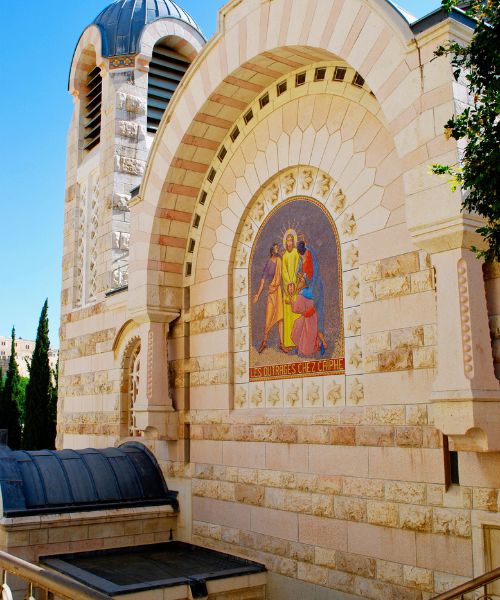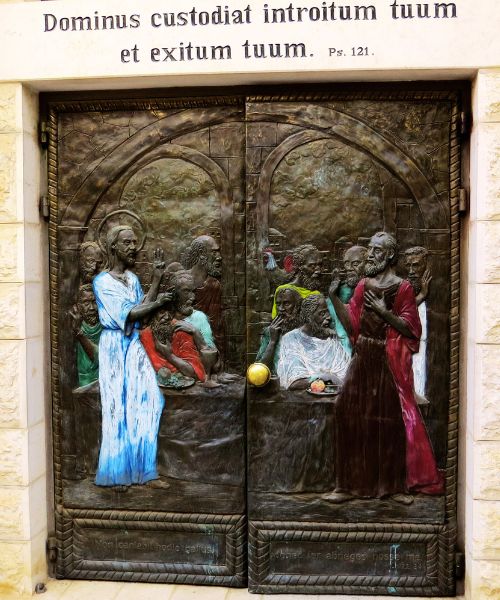The Church of Saint Peter in Gallicantu:When the Cock's Crowed
Introduction
The Saint Peter in Gallicantu church is dedicated to the biblical episode known as the Denial of Peter, where Peter, one of Jesus’ closest disciples, denied knowing Jesus three times after Jesus’ arrest. The term “Gallicantu” is Latin for “cock’s crow,” referring to Jesus’ prophecy that Peter would deny him three times before the cock crowed.

Location
The Church of Saint Peter in Gallicantu is a Roman Catholic church located on the eastern slope of Mount Zion, just outside the walled Old City of Jerusalem. You can enter the church from the parking lot located above the church.
Biblical Context
The Church of Saint Peter in Gallicantu is believed to be located on the site of the house of the high priest Caiaphas, where Jesus was taken after his arrest. According to the New Testament, it was here that Peter denied knowing Jesus three times, fulfilling Jesus’ prophecy. After realizing what he had done, Peter wept bitterly, showing his deep remorse for his actions. This event is recorded in all four Gospels.
Then he began to call down curses, and he swore to them, ‘I don’t know the man!’ Immediately a rooster crowed.
Then Peter remembered the word Jesus had spoken: ‘Before the rooster crows, you will disown me three times.’ And he went outside and wept bitterly.”
The church also commemorates Jesus’ imprisonment following his arrest. The dungeon beneath the church, known as “Christ’s Prison,” is believed to be the cell where Jesus was held. The church’s location and the events it commemorates make it a significant site for Christian pilgrims visiting Jerusalem.
The History of the Church of Saint Peter in Gallicantu
The Church of Saint Peter in Gallicantu has a rich and tumultuous history that reflects the broader history of religious sites in the Holy Land. The site has been a place of worship for centuries, with pilgrims’ reports dating back as far as AD 333 attesting to its significance. However, the church has also been subject to periods of destruction and reconstruction.
The first major church built on this site was constructed in 457 AD. This church was damaged in 529 AD during the Samaritan Revolt, a conflict between the Byzantine Empire and the Samaritans, a religious group related to Judaism. The church was then destroyed in 614 AD by the Persians during the Persian conquest of Jerusalem.
The church was rebuilt around 628 AD, only to be destroyed again in 1009 by the Fatimid Caliph Al-Hakim bi-Amr Allah. Al-Hakim was known for his erratic and unpredictable behavior, and his reign was marked by periods of intense religious persecution.
In 1100, the church of Saint Peter in Gallicantu was rebuilt by the Crusaders, who had established control over Jerusalem. However, the church was destroyed once again in 1219 by the Turks during the period of Ayyubid rule.
Following this period of destruction, a chapel was built on the site, but it too was destroyed around 1300. The site then lay in ruins for several centuries.
The present church was built in 1931 by the Assumptionist congregation, a French religious order established in 1887. The Assumptionists built the church over the ruins of the Byzantine basilica, incorporating elements of the ancient structure into the new church.
Excavations at the site have revealed a water cistern, corn mill, storage chambers, and servants’ quarters. Artefacts discovered include a complete set of weights and measures for liquids and solids as used by the priests in the Temple, and a door lintel with the word “Korban” (sacrificial offering) inscribed in Hebrew.
To the north of the church, there lies an ancient street paved with stepped stones. This path, which extends towards the Kidron Valley, allows visitors to tread on a 100-meter section that has been uncovered, revealing remnants from the Roman and Byzantine periods. It is believed that this stepped street may have once led to the Byzantine church of the Shiloam pool. Furthermore, during the Second Temple period, this pathway could have served as a route connecting the upper city to the lower city.



The Church's Multi-level Structure
The Church of Saint Peter in Gallicantu has a multi-level structure, each revealing unique archaeological findings: the upper church, middle church, guardroom, and dungeon.
Upper Church
The upper church is the main worship area, featuring a blend of contemporary and ancient art. The ceiling is a striking feature, dominated by a huge cross-shaped window designed in a radiant variety of colors. Three large mosaics cover the back wall and two side walls, depicting significant events from the New Testament. Two Byzantine-era mosaics, uncovered during excavation, are displayed inside the church. These mosaics were most likely part of the floor of the fifth-century Byzantine church that once stood on the site.
Middle Church
The middle church features icons above the altars that depict St Peter’s denial, his repentance, and his reconciliation with his Master on the shore of the Sea of Galilee after the Resurrection. Many of the inscriptions in the church are in French, reflecting the French origins of the Assumptionist congregation that built the church. Some parts of the middle churched incorporate ancient grottos in its walls.
Guardroom
The guardroom, hewn out of bedrock, contains wall fixtures to attach prisoners’ chains. Holes in the stone pillars would have been used to fasten a prisoner’s hands and feet. Bowls carved in the floor are believed to have contained salt and vinegar, either to aggravate the pain or to disinfect the wounds.
Dungeon
The dungeon is thought to be the cell where Jesus was detained for the night following his arrest. The only access to this bottle-necked cell was through a shaft from above, so the prisoner would have been lowered and raised by means of a rope harness. Looking down on the pit, several engraved Byzantine crosses are seen. A small window from the guardroom served as a peephole for a guard standing on a stone block. This sobering insight into where Christ might have spent the night before he was crucified has become known as “Christ’s Prison.”
This kind of cave-like chamber was common in Roman homes and were used as water cisterns, baths, and even cellars.
Sources:
Church of Saint Peter in Gallicantu – Wikipedia
Church of St Peter in Gallicantu – See The Holy Land
Saint Peter in Gallicantu Official site
BibleWalks
Nearby Sites
- Mount Zion: Mount Zion is a historic site that holds religious significance for Jews, Christians, and Muslims. It is home to several other important landmarks, including the Tomb of King David and the Room of the Last Supper.
- Zion Gate: Also known as David’s Gate, Zion Gate is one of the eight gates in the walls of the Old City of Jerusalem.
- Dormition Abbey: This massive basilica marks the site where the Virgin Mary is said to have died, or “fell into eternal sleep”.
- Pool of Siloam: An ancient pool where, according to the Bible, Jesus healed a man who had been blind since birth.



